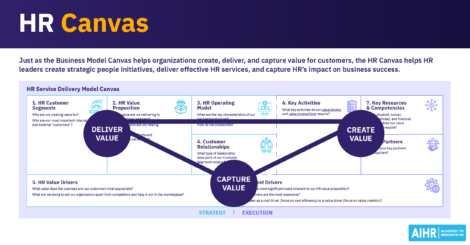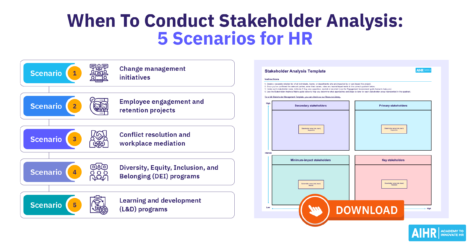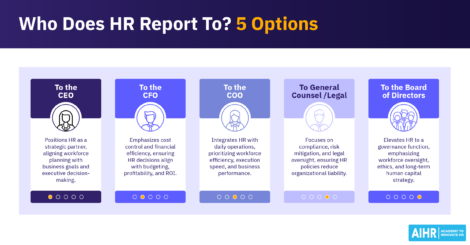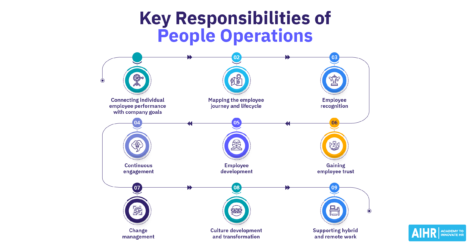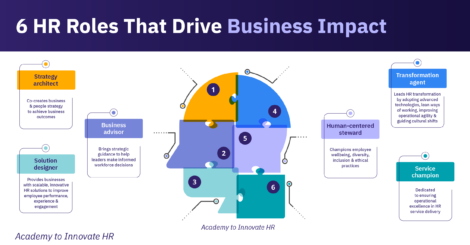HR SOP Template & Guide for HR Leaders
Do you have to write HR SOPs for every task? No. But you should write HR SOPs for at least some tasks. Why? Think about this: A study from Asana found that employees could save 260 hours of work a year if they simply had stronger processes in place. And that starts with having SOPs in place.

HR SOPs aren’t just nice-to-haves for your HR department — they are crucial in ensuring that your processes are streamlined, standardized, and effective. This is especially important when 62% of the workday can be lost to repetitive, mundane tasks. Creating SOPs can help your HR department save time and effort, allowing them to focus on impactful and strategic initiatives that can increase HR’s business value.
In this article, we’ll discuss what HR SOPs are, how they can enhance the effectiveness, productivity, and business impact of HR, and how you can create HR SOPs. You’ll also have access to a ready-to-use HR SOP template, so you don’t have to start from scratch. Let’s dive in!
Contents
What is SOP in HR?
The importance of streamlining HR processes with SOPs
Creating HR SOPs
HR SOP example
HR SOP template
What is SOP in HR?
An HR Standard Operating Procedure (SOP) is a documented guide with step-by-step instructions outlining specific processes, policies, and procedures for the HR department to follow.
HR SOPs cover all areas of the HR function, including Talent Acquisition and Management, Learning and Development, Employee Experience, and so on. They standardize HR operations, ensuring that you and your team perform HR tasks in a consistent and legal manner and in line with the organizational goals.
An HR SOP typically includes:
- The purpose and scope of the document
- The people who are responsible for each task or decision
- Step-by-step instructions for the procedure
- Information on legal requirements HR needs to follow
- Time frames of the procedure
- Guidelines on how to document the process
- Any relevant forms or templates.
Depending on the context of your organization, the HR SOPs you create will look different. For example, HR SOPs in larger organizations are more detailed and formalized, while those of smaller organizations are often less formal, containing more room for improvisation. If you work in the manufacturing industry, the SOPs you create might need to focus more on safety measures and compliance with industry-specific regulations.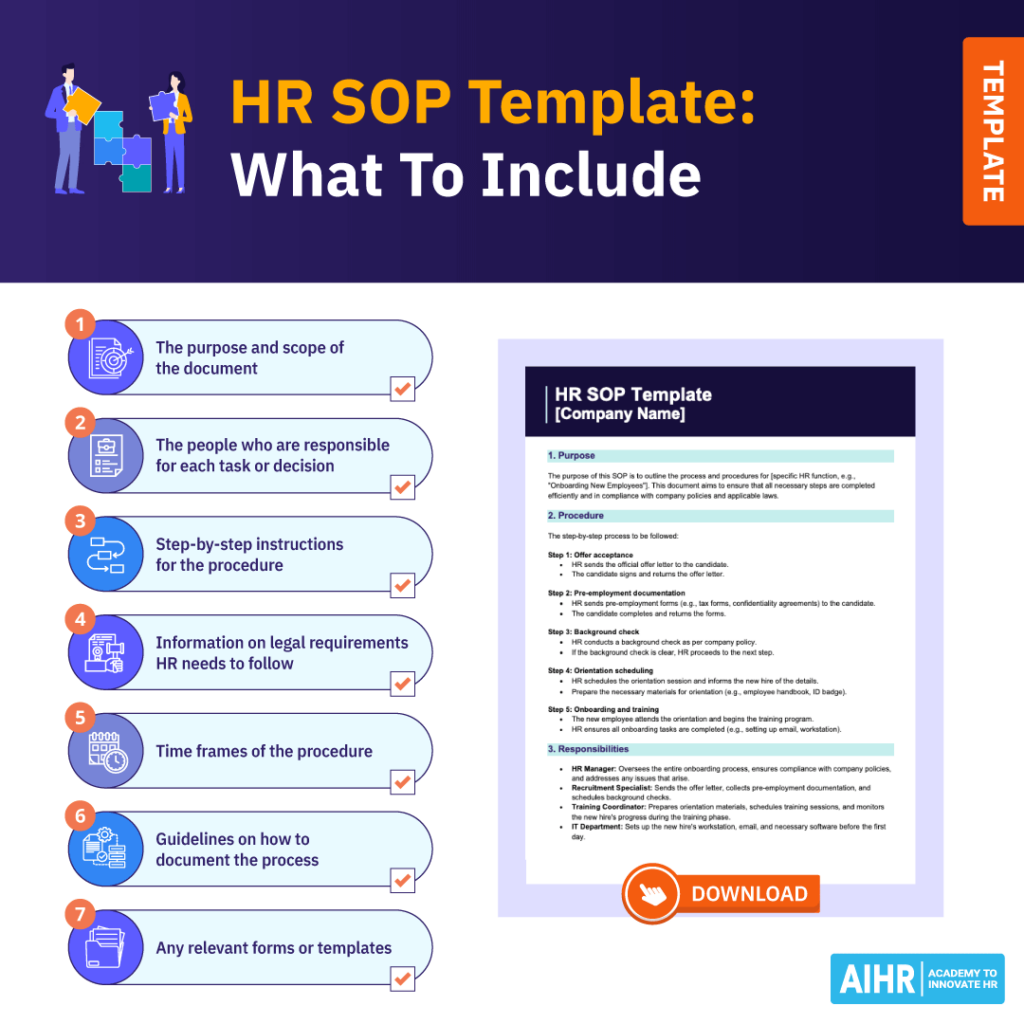
The importance of streamlining HR processes with SOPs
Standardized processes and operations greatly benefit any HR department and the wider organization. Here are a few reasons why it’s important for your team to have HR SOPs.
Ensuring consistency and standardization
SOPs enable your team to carry out HR processes consistently across the organization. This standardization helps eliminate discrepancies and confusion, minimize errors, and ensure that all employees are treated fairly and equally. SOPs also help reduce personal bias or subjectivity in decision-making, such as when it comes to hiring, promotions, or disciplinary actions.
For example, when setting compensation or bonuses, a standardized approach applies consistent criteria so that employees in similar roles with similar performance levels receive equitable rewards. This approach reduces the risk of pay discrepancies, promotes transparency, and bases compensation decisions on objective factors rather than individual discretion or bias.
Increasing efficiency and productivity
SOPs help streamline routine processes by breaking down complex tasks into manageable steps team members can follow. Instead of having to spend time figuring out processes, your team can follow clear instructions on what needs to be done, how it should be done, and in what order.
For instance, with a standardized onboarding SOP, HR teams across multiple locations can consistently and effectively provide new hires with a smooth onboarding experience.
By reducing the time and effort spent on completing routine tasks, HR can focus on more strategic and value-adding initiatives, such as leadership development, succession planning, or DEIB programs. This allows the Human Resources department to increase its impact and influence within the organization.
Maintaining compliance and managing risks
Formalizing processes and setting clear HR standards ensure that HR stays compliant with labor laws, regulations, and industry standards.
HR SOPs introduce a standardized approach to following regulations, provide guidelines on record-keeping and documentation, and provide a framework for updating processes as laws and regulations change. This way, organizations mitigate risks related to non-compliance and avoid legal issues and potential penalties.
Provide guidelines for new HR employees
SOPs can be a highly effective tool to bring your new HR staff up to speed. They offer new hires a structured learning path to familiarize themselves with routine processes and help them understand the organization’s expectations.
The new employees become productive more quickly. During and after their onboarding period, the SOPs can continue acting as an ongoing reference tool, especially when encountering unfamiliar situations or tasks.
In addition, all new HR employees will receive the same information and training regardless of who or where they are onboarded. This uniformity ensures that HR services continue to be reliable and high-quality. For instance, if every new HR hire follows the same steps to process payroll, errors are less likely to happen, and the process remains the same regardless of who handles it.
Encourage continuous improvement
When you have a clear and consistent baseline for how tasks should be performed, you’ll be able to assess the efficiency and effectiveness of HR operations. SOPs help you identify redundant or outdated processes and either remove or improve them. It also makes it easier to understand when there might be inefficiencies or underperformance you need to address.
For example, if the recruitment SOP specifies a set time frame for each stage, it’s much easier to identify any deviations from these time frames. This might signal that the actual process takes longer than the SOP suggests, and you need to update your SOP, or the employees responsible for the recruitment process might be underperforming.
Creating HR SOPs
1. Identify which HR processes need SOPs
Start with identifying the HR processes that could benefit the most from standardization. Your goal is to prioritize processes that are most critical or have the highest impact on the organization. You can conduct an audit of your existing processes using a Criticality-Impact Matrix: 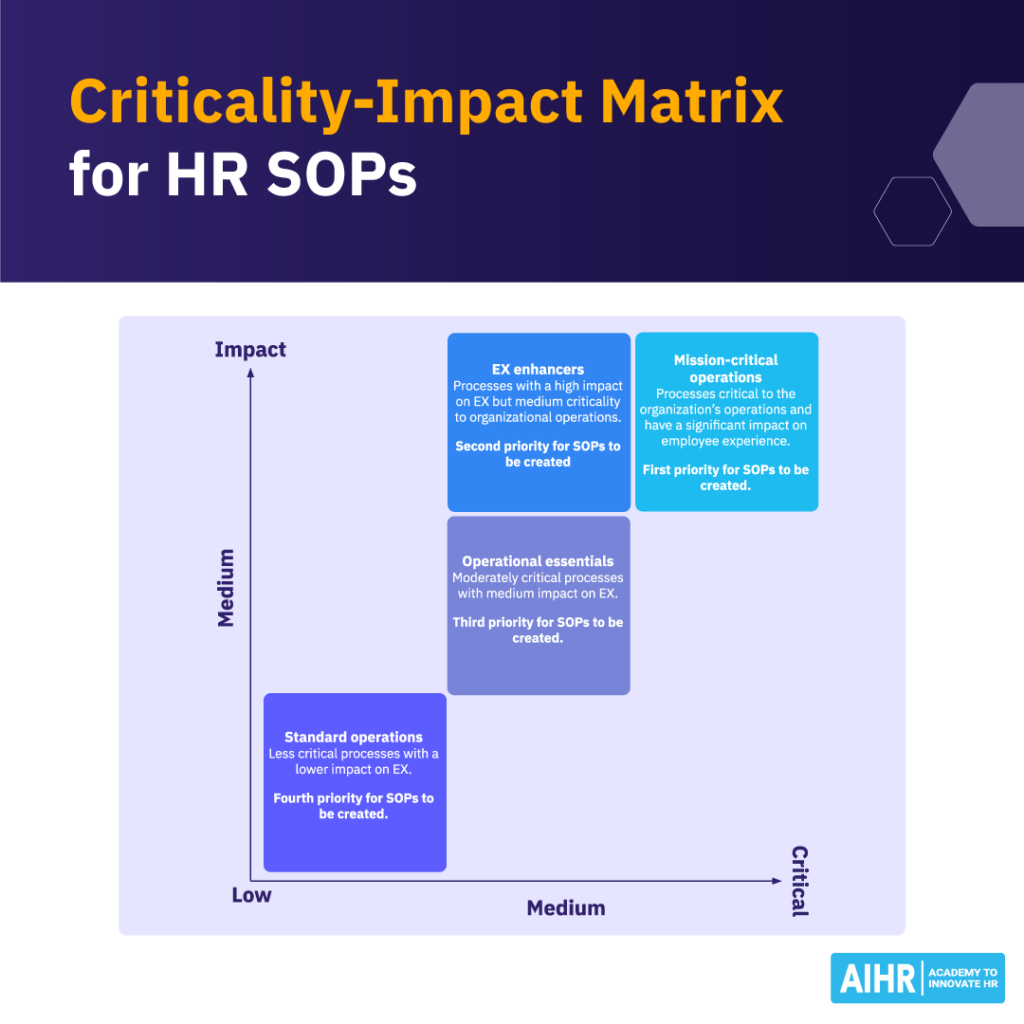
Once you’ve prioritized the processes, break them down further by assessing:
- Who is involved: Processes involving multiple teams, departments, or stakeholders are more likely to benefit from having SOPs to ensure everyone follows the same steps.
- Risk levels: Prioritize processes with high risks (legal, financial, or reputational), such as employee terminations, disciplinary actions, or documentation of sensitive information.
- Process frequency and volume: Focus on processes performed frequently and involve a large number of touchpoints or interactions.
2. Gather information
Once you’ve determined which processes need SOPs, it’s time to gather information about them. This includes:
- Understand the process: Get a broad understanding of the process you are documenting. Talk to your HR team members or relevant stakeholders to understand the goals, stakeholders, steps, best practices, and other relevant information to the processes.
- Consult subject matter experts: Seek input from those who have experience with the processes you want to write SOPs for. They can provide valuable insights into the nuances and challenges of the processes and help make your SOPs more comprehensive and accurate.
- Review existing procedures: Review any relevant policies or procedures and be sure to include them in the SOPs you create.
3. Outline the steps, responsibilities, and time frames
Start by breaking each process down into individual tasks and list them in sequential order. To maintain accountability, you should clearly define which role, individual, or team is responsible for completing each task.
If you have more complex processes involving multiple team members, you can use tools like the RACI matrix to clarify roles and responsibilities. This minimizes any confusion about who is responsible for what, especially with cross-functional processes.
You’ll also need to set a clear timeline for each step of the process to make sure tasks are completed promptly and efficiently. Set realistic deadlines and include buffer time to account for unexpected delays. If you’re not sure what is a reasonable time frame for a task, talk to team members who have done it before to get an idea.
4. Develop a style guide
If you want to introduce consistency in your HR department, start with the SOPs. Develop a style guide to create clear and concise SOP documents that others can follow. This ensures all of your SOPs are in line with one another and helps you cut down time when you need to create a new SOP.
So, what can you include in this style guide? Well, that would depend on the specific context of your organization, such as the industry, preferred communication style, or country where you’re located. That being said, here are a few common elements that you can include:
- Straightforward, jargon-free language: Make sure the SOPs are readable and easy to understand. If your employees don’t understand the instructions, they won’t be able to follow them and carry out the process.
- Consistent formatting and structure: Provide detailed instructions on how to format the document (e.g., font type, font size, headings and subheadings, bullets, numbering, etc.) and what structure to follow.
- Visual aids: Use checklists, flowcharts, or diagrams to create more clarity, especially for complex processes. Don’t forget to include best practices on how to incorporate these elements and link them to the tools or software to create visual aids.
- Standardized terminologies: Include a list of terms and abbreviations people can use across all SOPs to make sure everyone understands the terminologies in the SOPs.
5. Review and validate SOPs
Don’t forget to have subject matter experts review the SOPs to ensure they are accurate and complete. It’s always useful to have one or several sets of eyes to catch any mistakes or inaccuracies you might have missed, especially when these documents will act as guidelines for all HR staff.
6. Create a centralized SOP repository
Now that you have your SOPs think about where you’re going to store them so that they are secure but easy to access and navigate for your HR department. Here are three options you can consider:
Intranet-based
Store your SOPs on the company’s intranet
- Easy to store in a structured format with categories and search functionalities
- Possible to customize access control depending on the user’s role
- Might require initial software and IT resources to set up
- Need regular updates and maintenance
Shared drive
Store your SOPs on a cloud-based or on-premise shared drive
- Easy for HR employees to navigate
- Possible to set permissions at the folder or file level
- Pose potential security risks if there are no strong protection measures
- Dependent on internet connectivity to function
Document management system (DMS)
Store your SOPs on a DMS — a specialized software to store, manage, and track electronic documents
- Allow for granular access control down to specific sections of a document
- Possible to automate the SOPs approval and review process
- Offer advanced search capabilities based on tags, keywords, or metadata
- Complex to implement and expensive
- Might need to be integrated with other systems in your organization
Regardless of which option you go for, don’t forget to implement strong access control to protect sensitive information and maintain the integrity of your SOPs. You can implement:
- Role-based access: Based on their roles, allow only authorized employees to view and edit specific SOPs.
- User authentication: Use measures like complex passwords or two-factor authentication to safeguard your repository.
- Audit trails: Track and document who accesses or modifies documents in your repository to use when there are discrepancies or security concerns.
7. Train your HR team
Create a guide with clear and straightforward instructions to help your team navigate, understand, and apply the SOPs in their day-to-day work. Include instructions on how to:
- Access and navigate the repository: Provide step-by-step instructions on how to access the HR SOPs, go to the right sections, and use the search function.
- Navigate the SOP’s structure: Explain the structure of the SOP and what each section contains.
- Apply the SOPs: Provide examples of how to use the SOPs in real-life work situations.
You can either have this guide in a written format or include more interactive materials like video tutorials. These will act as ongoing support materials for your team that they can refer back to at any time, so make sure they are easily accessible.
Beyond these, you will also need to organize trainings and regular refresher sessions to ensure your team is comfortable with using the new SOPs. Assign a dedicated SOP coordinator your team can come to whenever they need something.
8. Put the SOPs to work
It’s now time to inform all relevant stakeholders about the new SOPs and how to utilize them. You can send out an email containing all the necessary links and guidelines.
Remember to include the name and contact details of the designated contact person for the SOPs in case anyone has any questions. Regularly monitor the use of the SOPs to ensure everyone follows them.
9. Maintain and review
Conducting regular reviews of the SOPs helps you ensure that they remain effective, relevant, and aligned with your organization’s current best practices and policies.
How often you do these reviews will depend on the SOPs themselves or the broader context. Annual reviews are sufficient for most SOPs. However, those that are more dynamic (e.g., SOPs related to compliance or new technology) need to be reviewed more frequently, such as every six months. You can also do trigger-based reviews whenever something happens that requires your SOP to be modified immediately.
Gather feedback from those who use the SOPs regularly. You can send out surveys and questionnaires, have one on one discussions, or link to feedback forms directly in the SOPs. It’s also good to have a coordinator or a cross-functional team to be responsible for reviewing and updating the SOPs. This ensures that the review process is consistent and effective.
HR SOP example
To give you an idea of what an HR SOP can look like, here is a sample SOP for employee onboarding for a mid-sized retail company based in the United States. Keep in mind that this is a simplified example of what an onboarding SOP would look like. When creating this document, don’t forget to tailor it to the context and unique onboarding process of your organization.
HR SOP template
If you want to create HR SOPs for your team but aren’t sure where to start, don’t worry! We’ve created this ready-to-use HR SOP template to help you save time and effort. You can easily customize the template based on the needs and requirements of your HR department and the organization.
Simply click on the button below to download the template, and you can get started right away on documenting HR procedures and processes.
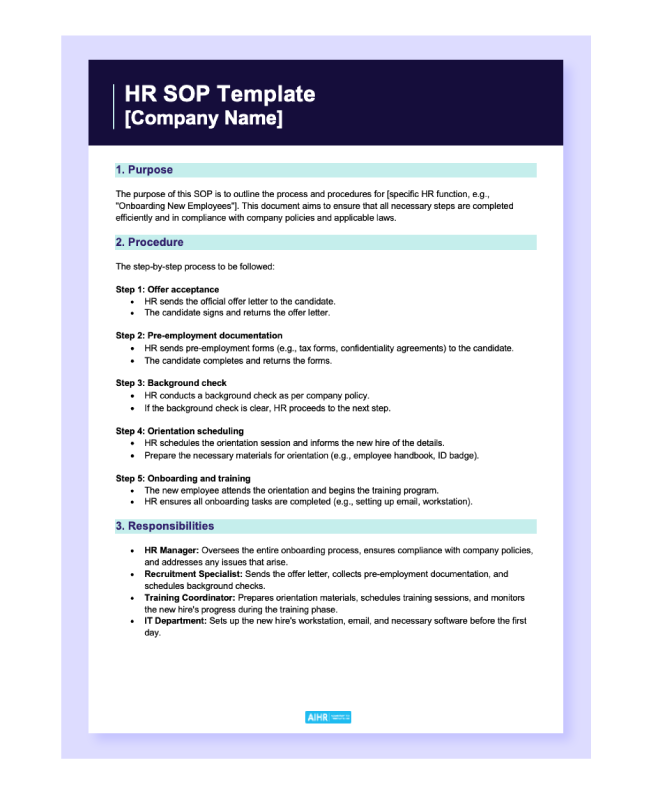
Key takeaway
HR SOPs play a crucial role in ensuring that your team is efficient, productive, and aligned and can deliver consistent and high-quality HR services. Make sure to select the most impactful processes for creating SOPs, and don’t forget to update these documents regularly to ensure your processes are always up-to-date and in line with what your organization wants to achieve.
Learn more
Related articles
Are you ready for the future of HR?
Learn modern and relevant HR skills, online







